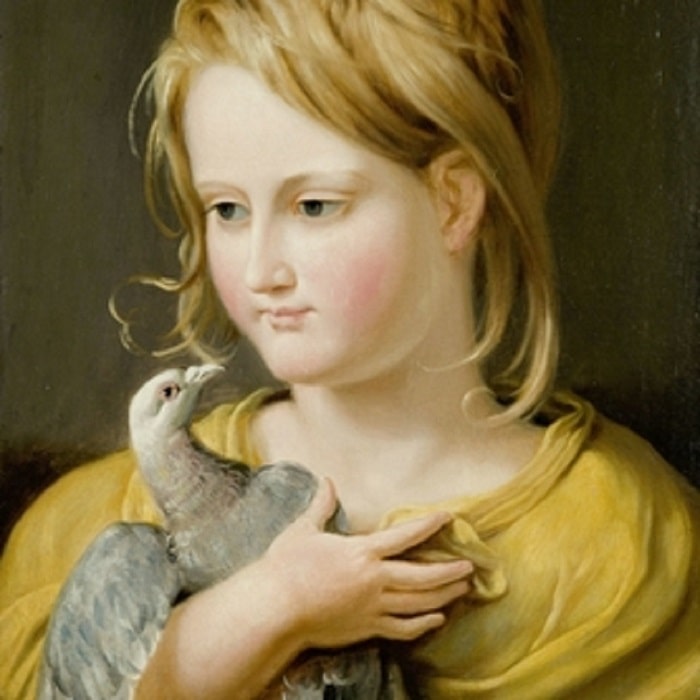The fragile construct of a peaceful Europe has collapsed with the invasion of Russian troops in Ukraine. The Germanisches Nationalmuseum is taking the current situation as an opportunity to show objects for a whole year that stand in the context of peace and war. They serve as an impetus to reflect on the historical dimension of wars and the patterns of argumentation for and against combative confrontations that have existed for centuries.
Image above: Johann Heinrich Wilhelm Tischbein: Portrait of his daughter Ernestine, c. 1810 Oil on canvas Germanisches Nationalmuseum, Nuremberg Photo: GNM
The presentation changes every three months and shows a new selection of 15 to 20 exhibits each time. The first of these are 16 works from different epochs and genres that celebrate peace or, on the contrary, refer to the traumatising atrocities of war.
The first glance falls on a painting by Johann Wilhelm Heinrich Tischbein from 1810, which shows his daughter Ernestine. The child is cautiously holding a dove in her arms. The dove as a symbol of love and peace has a long tradition in cultural history: in the ancient Orient, the bird was regarded as the companion of the goddess of love, and Christian art knows it as the bearer of an olive branch to Noah, representing the end of the Flood and thus peace between God and man. In the New Testament, the dove symbolises the Holy Spirit, God’s omnipresence on earth. Tischbein’s painting was created against the background of Napoleon’s warlike reorganisation of Europe. The wish for his daughter to live a life of peace is therefore not surprising.
Peace and war – a centuries-old cycle
Conflicts have shaped humanity for centuries; until well into modern times, warlike confrontations were a natural part of many people’s everyday lives. Detailed and with precise strokes, Jacques Callot’s famous graphic series from the 1630s tells of the misery and horror of war, from which seven etchings are exhibited. Models of war equipment from the Nuremberg armoury and a toy flak car demonstrate the fascination that can emanate from powerful weapons and to which even children should be introduced.
Accordingly, the longing for peaceful times was always great.
The oldest exhibit in the current presentation is a copper engraving depicting a bonfire burned in 1598 to mark the end of the Huguenot War. Two peace medals from the 30 Years War, minted before its end, bear witness to the same wish for a future free of violence. Their obverses show the personification of “Pax”, peace, an inscription on the reverse hopes that with it “justice and displaced prosperity will return to earth.”

War as a waste of resources
Wars are always accompanied by high losses; from a calculative point of view, they are a gigantic waste of resources. A box of war debris in the middle of the room, fragments of historical sculptures from the museum’s own collection that were presumably destroyed in 1943, vividly illustrates this. Even cultural assets are not safe from the ravages of war – on the contrary, their destruction often has symbolic meaning. The box is backed by Gerhard Richter’s “Bridge 14 FEB 1945 (II)”, an offset print after a photograph of the war-ravaged city of Cologne taken from an American military aircraft, and on the other side by Harald Duwe’s large-format, grey-brown painting of faceless bomb victims lying on the ground.
Modern, open societies have little interest in wasting people, energy, creativity, prosperity options etc. in violent conflicts. Posters of the peace movement from the 1970s express this hope and urge us not to forget it. For the realisation peace makes prosperity possible, war destroys it does not come about by itself. Humanity must remember in order to understand what it has to lose.
Every three months, the thematic focus and thus the selection of objects change. The next changes will take place on 2 November 2022, 7 February 2023 and 9 May 2023.
The studio exhibition is based on a concept by Prof. Dr Magnus Brechtken from the Institute of Contemporary History Munich – Berlin.
WHERE?
Germanisches Nationalmuseum
Kartäusergasse 1
90402 Nürnberg
WHEN?
Tuesday, 06 September 2022 until Sunday, 30 July 2023
COST?
included in the admission fee of 8,- € / reduced 5,- €






